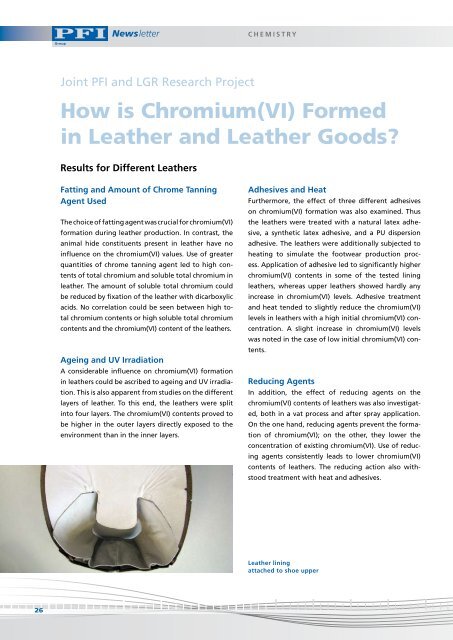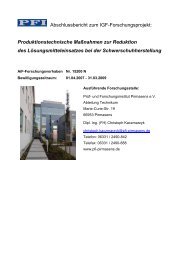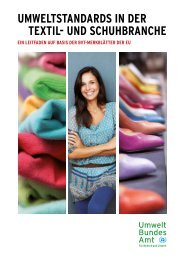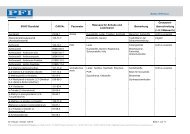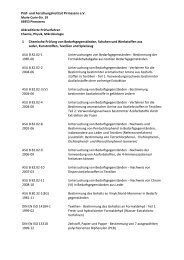Here - PFI Group
Here - PFI Group
Here - PFI Group
You also want an ePaper? Increase the reach of your titles
YUMPU automatically turns print PDFs into web optimized ePapers that Google loves.
26<br />
Newsletter<br />
Joint <strong>PFI</strong> and LGR Research Project<br />
Results for Different Leathers<br />
Fatting and Amount of Chrome Tanning<br />
Agent Used<br />
The choice of fatting agent was crucial for chromium(VI)<br />
formation during leather production. In contrast, the<br />
animal hide constituents present in leather have no<br />
influence on the chromium(VI) values. Use of greater<br />
quantities of chrome tanning agent led to high contents<br />
of total chromium and soluble total chromium in<br />
leather. The amount of soluble total chromium could<br />
be reduced by fixation of the leather with dicarboxylic<br />
acids. No correlation could be seen between high total<br />
chromium contents or high soluble total chromium<br />
contents and the chromium(VI) content of the leathers.<br />
Ageing and UV Irradiation<br />
A considerable influence on chromium(VI) formation<br />
in leathers could be ascribed to ageing and UV irradiation.<br />
This is also apparent from studies on the different<br />
layers of leather. To this end, the leathers were split<br />
into four layers. The chromium(VI) contents proved to<br />
be higher in the outer layers directly exposed to the<br />
environment than in the inner layers.<br />
CHEMISTRY<br />
How is Chromium(VI) Formed<br />
in Leather and Leather Goods?<br />
Adhesives and Heat<br />
Furthermore, the effect of three different adhesives<br />
on chromium(VI) formation was also examined. Thus<br />
the leathers were treated with a natural latex adhesive,<br />
a synthetic latex adhesive, and a PU dispersion<br />
adhesive. The leathers were additionally subjected to<br />
heating to simulate the footwear production process.<br />
Application of adhesive led to significantly higher<br />
chromium(VI) contents in some of the tested lining<br />
leathers, whereas upper leathers showed hardly any<br />
increase in chromium(VI) levels. Adhesive treatment<br />
and heat tended to slightly reduce the chromium(VI)<br />
levels in leathers with a high initial chromium(VI) concentration.<br />
A slight increase in chromium(VI) levels<br />
was noted in the case of low initial chromium(VI) contents.<br />
Reducing Agents<br />
In addition, the effect of reducing agents on the<br />
chromium(VI) contents of leathers was also investigated,<br />
both in a vat process and after spray application.<br />
On the one hand, reducing agents prevent the formation<br />
of chromium(VI); on the other, they lower the<br />
concentration of existing chromium(VI). Use of reducing<br />
agents consistently leads to lower chromium(VI)<br />
contents of leathers. The reducing action also withstood<br />
treatment with heat and adhesives.<br />
Leather lining<br />
attached to shoe upper


